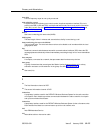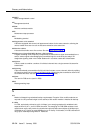
Glossary and Abbreviations
555-230-024GL-30 Issue 5 January 1998
line port
Hardware that provides the access point to a communications system for each circuit associated
with a telephone or data terminal.
link
A transmitter-receiver channel that connects two systems.
link-access procedure on the D-channel (LAPD)
A link-layer protocol on the ISDN-BRI and ISDN-PRI data-link layer (level 2). LAPD provides data
transfer between two devices, and error and flow control on multiple logical links. LAPD is used
for signaling and low-speed packet data (X.25 and mode 3) on the signaling (D-) channel and for
mode-3 data communications on a bearer (B-) channel.
LINL
Local indirect neighbor link
local area network (LAN)
A networking arrangement designed for a limited geographical area. Generally, a LAN is limited in
range to a maximum of 6.2 miles and provides high-speed carrier service with low error rates.
Common configurations include daisy chain, star (including circuit-switched), ring, and bus.
logical link
The communications path between a processor and a BRI terminal.
loop-start trunk
A trunk on which, after establishing a connection with a distant switching system for an outgoing
call, the system waits for a signal on the loop formed by the trunk leads before sending the digits
of the called number.
LSU
Local storage unit
LWC
Leave Word Calling
M
MAC
Medium access
MADU
Modular asynchronous data unit
main distribution frame (MDF)
A device that mounts to the wall inside the system equipment room. The MDF provides a
connection point from outside telephone lines to the PBX switch and to the inside telephone
stations.
main-satellite-tributary
A private network configuration that can either stand alone or access an ETN. A main switch
provides interconnection, via tie trunks, with one or more subtending switches, called satellites; all
attendant positions for the main/satellite configuration; and access to and from the public
network. To a user outside the complex, a main/satellite configuration appears as one switch, with


















